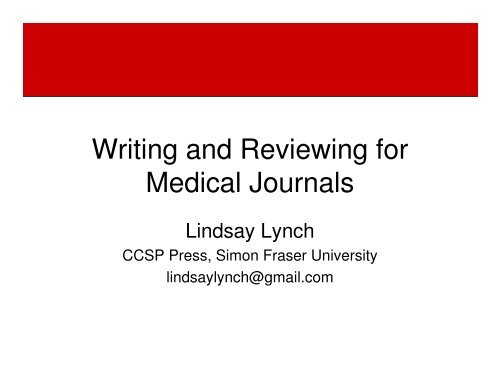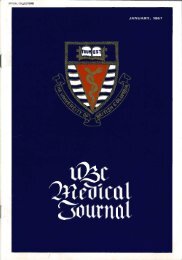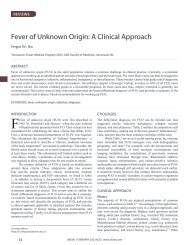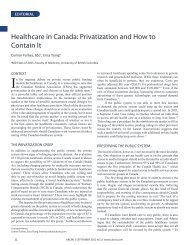Peer Review Presentation - UBC Medical Journal
Peer Review Presentation - UBC Medical Journal
Peer Review Presentation - UBC Medical Journal
Create successful ePaper yourself
Turn your PDF publications into a flip-book with our unique Google optimized e-Paper software.
Writing and <strong>Review</strong>ing for<br />
<strong>Medical</strong> <strong>Journal</strong>s<br />
Lindsay Lynch<br />
CCSP Press, Simon Fraser University<br />
lindsaylynch@gmail.com
Outline<br />
• Purpose of peer review<br />
• Link between writing and reviewing<br />
• Dual role of reviewer<br />
• <strong>Review</strong>er responsibilities<br />
• Format of reviews<br />
• Reasons reviewers accept & reject<br />
manuscripts<br />
• Advice for authors
Purpose of <strong>Peer</strong> <strong>Review</strong><br />
To ensure:<br />
1. No mistakes in procedure or logic<br />
2. Results support conclusion<br />
3. No citation errors<br />
4. Adherence to ethics protocols and<br />
approval by institutional review<br />
committees<br />
5. Work is “original and significant” (p. 48)<br />
Buenos, D.J., Kirk, K.L., & Hall, J.E. (2003). How to review a paper. Advan Physiol Educ 27:47-52, 2003. doi:10.1152/advan.00057.2002
Good <strong>Review</strong>ers, Great Authors<br />
• By knowing what reviewers look for,<br />
authors can prospectively address<br />
questions reviewers are likely to ask<br />
→ The more reviewing you do, the more<br />
comfortable you will become as an author<br />
Provenzale, J.M., & Stanley, R.J. (2006). A systematic guide to reviewing a manuscript. <strong>Journal</strong> of Nuclear<br />
Medicine Technology, 34(2): 92-99. Originally published in American <strong>Journal</strong> of Roentgenology, 2005.
Dual Role of the <strong>Review</strong>er<br />
Author advocate<br />
• to see what the authors have not seen<br />
“If a reviewer acts as an ‘author advocate,’<br />
then many potential problems that may arise<br />
during the peer review process will be<br />
avoided.” (p. 48, italics added)<br />
<strong>Journal</strong> advocate<br />
• ensure “best possible science” becomes<br />
part of the permanent record (p. 48)<br />
Buenos, D.J., Kirk, K.L., & Hall, J.E. (2003). How to review a paper. Advan Physiol Educ 27:47-52, 2003. doi:10.1152/advan.00057.2002
Dual Role of the <strong>Review</strong>er<br />
To provide feedback that is:<br />
a)helpful to editors → judge whether manuscript<br />
merits publication by providing global rating<br />
b)instructive for authors → provide constructive<br />
criticism for author, regardless of whether<br />
manuscript deemed acceptable for publication<br />
(p. 92)<br />
Provenzale, J.M., & Stanley, R.J. (2006). A systematic guide to reviewing a manuscript. <strong>Journal</strong> of Nuclear<br />
Medicine Technology, 34(2): 92-99. Originally published in American <strong>Journal</strong> of Roentgenology, 2005.
<strong>Review</strong>er Responsibilities<br />
1. Provide honest, critical assessment of the<br />
research<br />
2. Maintain confidentiality about the existence<br />
and substance of the manuscript<br />
3. Must not participate in plagiarism<br />
4. Avoid, or disclose, any conflicts of interest<br />
5. Accept manuscripts for review only in his/her<br />
areas of expertise<br />
Buenos, D.J., Kirk, K.L., & Hall, J.E. (2003). How to review a paper. Advan Physiol Educ 27:47-52, 2003. doi:10.1152/advan.00057.2002
<strong>Review</strong>er Responsibilities<br />
6. Agree to review only those manuscripts that<br />
can be completed on time<br />
7. Report suspected duplicate publication, fraud,<br />
plagiarism, or ethical concerns about use of<br />
animals or humans in research being reported<br />
8. Write reviews in collegial, constructive manner<br />
(p. 49-50)<br />
Buenos, D.J., Kirk, K.L., & Hall, J.E. (2003). How to review a paper. Advan Physiol Educ 27:47-52, 2003. doi:10.1152/advan.00057.2002
Golden Rule<br />
“Treat all manuscripts in the<br />
same manner that you would<br />
want your own treated.” (p. 48)<br />
Buenos, D.J., Kirk, K.L., & Hall, J.E. (2003). How to review a paper. Advan Physiol Educ 27:47-52, 2003. doi:10.1152/advan.00057.2002
Golden Rule<br />
• Provide a critique that is positive, critical yet<br />
objective, balanced<br />
• Avoid personally offensive comments, sarcasm<br />
• Indicate precisely what the problems are and<br />
how they may be overcome<br />
• Complete and return promptly<br />
→ “A confusing or uninformative critique is not<br />
helpful either to the authors or to the editor.”<br />
(p.48)<br />
Buenos, D.J., Kirk, K.L., & Hall, J.E. (2003). How to review a paper. Advan Physiol Educ 27:47-52, 2003. doi:10.1152/advan.00057.2002
Format of <strong>Review</strong><br />
Two parts to a review:<br />
1. Substantive evaluation<br />
2. Recommendation<br />
• Accept<br />
• Accept pending revisions<br />
• Reconsider after major revisions<br />
• Reject<br />
Provenzale, J.M., & Stanley, R.J. (2006). A systematic guide to reviewing a manuscript. <strong>Journal</strong> of Nuclear<br />
Medicine Technology, 34(2): 92-99. Originally published in American <strong>Journal</strong> of Roentgenology, 2005.
Informative <strong>Review</strong><br />
Shows that the reviewer:<br />
• Performed a close reading of the manuscript<br />
• Thought carefully about the most important<br />
sections of the manuscript<br />
• Provided constructive criticisms for the authors<br />
• Assigned a rating that is commensurate with the<br />
remainder of the review (p. 97)<br />
Provenzale, J.M., & Stanley, R.J. (2006). A systematic guide to reviewing a manuscript. <strong>Journal</strong> of Nuclear<br />
Medicine Technology, 34(2): 92-99. Originally published in American <strong>Journal</strong> of Roentgenology, 2005.
Non-Informative <strong>Review</strong>s<br />
The “snapshot verdict”<br />
– Indicates only that the reviewer has read the<br />
manuscript and whether or not he/she liked it (p. 97)<br />
Example<br />
“I read the manuscript on renal calculi that you<br />
sent me. I found no problems with it. I think it is<br />
the first time that this work has been done. This<br />
manuscript should be published.<br />
Recommendation: Accept.”<br />
Provenzale, J.M., & Stanley, R.J. (2006). A systematic guide to reviewing a manuscript. <strong>Journal</strong> of Nuclear<br />
Medicine Technology, 34(2): 92-99. Originally published in American <strong>Journal</strong> of Roentgenology, 2005.
Non-Informative <strong>Review</strong>s<br />
The “mixed-signals review”<br />
– Narrative summary leads to one conclusion, but<br />
reviewer provides a Recommendation counter to the<br />
expected one (p. 97)<br />
Example<br />
“This manuscript has a number of major<br />
shortcomings: The authors have not adequately<br />
reviewed the medical literature on renal calculi,<br />
they provide insufficient detail regarding how<br />
patients were chosen for the study, and the<br />
Results section has many inconsistencies.<br />
Recommendation: Accept Pending Revisions.”<br />
Provenzale, J.M., & Stanley, R.J. (2006). A systematic guide to reviewing a manuscript. <strong>Journal</strong> of Nuclear<br />
Medicine Technology, 34(2): 92-99. Originally published in American <strong>Journal</strong> of Roentgenology, 2005.
Non-Informative <strong>Review</strong>s<br />
The “hidden-agenda review“<br />
– Opinions in the confidential note to the editor substantially differ<br />
from those expressed in the portion of the review available to the<br />
authors (p. 97-98)<br />
Example<br />
“This study is a good comparison between conventional CT and 16-<br />
MDCT for evaluation of renal calculi. The manuscript could be<br />
improved by better documentation of the previous medical literature,<br />
a clearer explanation of how readers scored the images and of the<br />
selection criteria, clarification of some inconsistencies between the<br />
stated results and Table 1, and a better explanation of how the CT<br />
scan parameters affect the sensitivity of MDCT. Recommendation:<br />
Accept Pending Revisions.<br />
Confidential Note to the Editor: There are some serious flaws here.<br />
The authors show a lack of understanding of the factors that come<br />
into play in renal calculus detection by CT. The Methods section<br />
needs a lot of work.”<br />
Provenzale, J.M., & Stanley, R.J. (2006). A systematic guide to reviewing a manuscript. <strong>Journal</strong> of Nuclear<br />
Medicine Technology, 34(2): 92-99. Originally published in American <strong>Journal</strong> of Roentgenology, 2005.
Reasons <strong>Review</strong>ers Accept<br />
Manuscripts<br />
• Timely and relevant to a current problem<br />
• Well written, logical, and easy to comprehend<br />
• Study well designed and had appropriate<br />
methodology (p. 93)<br />
Provenzale, J.M., & Stanley, R.J. (2006). A systematic guide to reviewing a manuscript. <strong>Journal</strong> of Nuclear<br />
Medicine Technology, 34(2): 92-99. Originally published in American <strong>Journal</strong> of Roentgenology, 2005.
Reasons <strong>Review</strong>ers Reject<br />
Manuscripts<br />
• Incomplete or insufficiently described statistics<br />
• Overinterpretation of the results<br />
• Suboptimal or insufficiently described means of<br />
measuring data<br />
• Sample population too small or biased*<br />
• Text difficult to follow<br />
• Insufficient problem statement (p. 93)<br />
Provenzale, J.M., & Stanley, R.J. (2006). A systematic guide to reviewing a manuscript. <strong>Journal</strong> of Nuclear<br />
Medicine Technology, 34(2): 92-99. Originally published in American <strong>Journal</strong> of Roentgenology, 2005.
Advice for Authors<br />
• Authors shouldn’t feel as though they are<br />
at the mercy of reviewers<br />
• Editor makes decision, not reviewers<br />
• If you feel a reviewer has given biased or<br />
unjustified comments, don’t be afraid to<br />
present your argument to the editor
Resources<br />
Budgell, Brian S. (2009). Writing a biomedical research<br />
paper: A guide to structure and style. Tokyo, New York:<br />
Springer.<br />
Buenos, D.J., Kirk, K.L., & Hall, J.E. (2003). How to review<br />
a paper. Advan Physiol Educ 27:47-52, 2003.<br />
doi:10.1152/advan.00057.2002<br />
Provenzale, J.M., & Stanley, R.J. (2006). A systematic<br />
guide to reviewing a manuscript. <strong>Journal</strong> of Nuclear<br />
Medicine Technology, 34(2): 92-99. Originally published<br />
in American <strong>Journal</strong> of Roentgenology, 2005.










